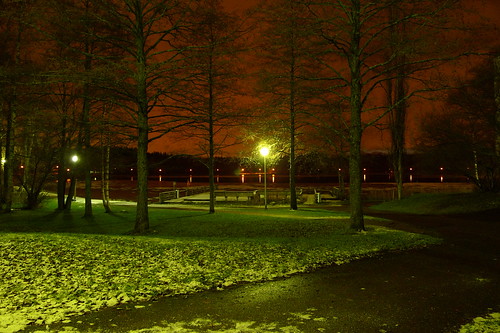Some users of the Panasonic LX3 are recommending the iA mode, which is fully automated "scene-mode" based system for novices. When I got the camera, I used iA, but then I moved to aperture priority and manual focus as the primary settings. However, I'm still using automatic white balance (though a bit tweaked), and auto-ISO and intelligent exposure. Perhaps I should move away from these as well.
Here is a photo where using the RAW format might have been useful to determine the correct white balance settings in post-processing. I'm not saying that the results is bad, but it would have been interesting to explore the possibilities.
As a sidenote, I have been planning to do some work in finding the right white balance settings to use with street lamps etc. There are a lot of options for doing this with the LX3, so I'm hesitating before tackling the problem. I want to take photos, not tinker with the settings.
There’s another question I’d like the answer to.
6 hours ago




4 comments:
Automatic? Why not? Less hassle and it lets you concentrate on the photo, not the settings! The end justifies the means! ;-)
Well, there are several types of automatics.
Program mode which selects both aperture and shutter speed does often a competent job. But when you need a certain depth-of-field or want a deliberate motion blur, then that does not work.
But the Panasonic iA is a bit different, and I have found it unpredictable. (And I feel that automatics should be somewhat predictable.) The iA mode raises ISO automatically, uses different focusing and exposure metering modes depending on the scene mode it selects, and so on.
In the iA mode you have "an artificial photographer" living in the camera, and I don't like to out-guess and compete with it.
I can't comment on the LX3, but on Nikon DSLRs there is generally no good reason not to use auto ISO. You set a maximum shutter time that you can hold, and the camera adjusts ISO. It's exactly what you'd have to do to get the shot, only you don't have to do it.
Other than that I use aperture priority most of the time, speed priority for birds and manual sometimes from the tipod, but then most of the time bulb mode for night shots. That's it.
Most of the time I use the aperture creatively, i.e. shoot wide open, and then intelligent automatics tend to disagree :)
This works about the same on the LX3 - you can sent the max ISO and max shutter time. But as the LX3 is a small-sensor camera, the reasonable max is not as high as with a good DSLR such as your Nikon. And the max shutter time is limited at 1/8 seconds. I often want to use longer even with handheld photos (usually 1/4 second exposures are sharp).
One thing which is probably worth checking out though is how well the iA mode copes with snowy scenes. Having very dark and very light elements in a photo is quite challenging.
Post a Comment